warning light FIAT DOBLO COMBI 2016 2.G Manual PDF
[x] Cancel search | Manufacturer: FIAT, Model Year: 2016, Model line: DOBLO COMBI, Model: FIAT DOBLO COMBI 2016 2.GPages: 298, PDF Size: 25.92 MB
Page 182 of 298
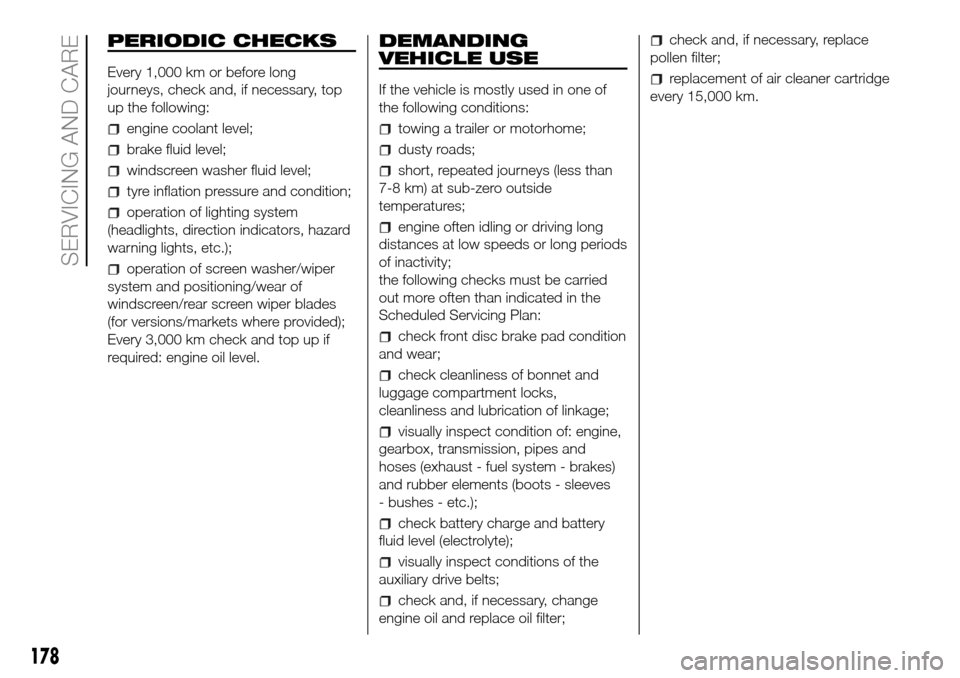
PERIODIC CHECKS
Every 1,000 km or before long
journeys, check and, if necessary, top
up the following:
engine coolant level;
brake fluid level;
windscreen washer fluid level;
tyre inflation pressure and condition;
operation of lighting system
(headlights, direction indicators, hazard
warning lights, etc.);
operation of screen washer/wiper
system and positioning/wear of
windscreen/rear screen wiper blades
(for versions/markets where provided);
Every 3,000 km check and top up if
required: engine oil level.
DEMANDING
VEHICLE USE
If the vehicle is mostly used in one of
the following conditions:
towing a trailer or motorhome;
dusty roads;
short, repeated journeys (less than
7-8 km) at sub-zero outside
temperatures;
engine often idling or driving long
distances at low speeds or long periods
of inactivity;
the following checks must be carried
out more often than indicated in the
Scheduled Servicing Plan:
check front disc brake pad condition
and wear;
check cleanliness of bonnet and
luggage compartment locks,
cleanliness and lubrication of linkage;
visually inspect condition of: engine,
gearbox, transmission, pipes and
hoses (exhaust - fuel system - brakes)
and rubber elements (boots - sleeves
- bushes - etc.);
check battery charge and battery
fluid level (electrolyte);
visually inspect conditions of the
auxiliary drive belts;
check and, if necessary, change
engine oil and replace oil filter;
check and, if necessary, replace
pollen filter;
replacement of air cleaner cartridge
every 15,000 km.
178
SERVICING AND CARE
Page 193 of 298
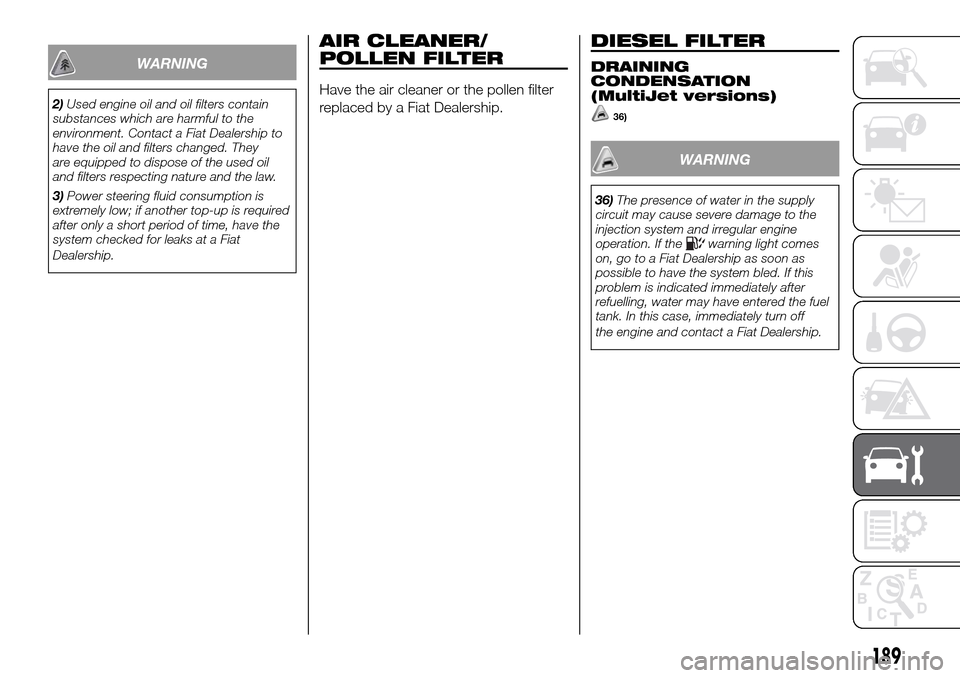
WARNING
2)Used engine oil and oil filters contain
substances which are harmful to the
environment. Contact a Fiat Dealership to
have the oil and filters changed. They
are equipped to dispose of the used oil
and filters respecting nature and the law.
3)Power steering fluid consumption is
extremely low; if another top-up is required
after only a short period of time, have the
system checked for leaks at a Fiat
Dealership.
AIR CLEANER/
POLLEN FILTER
Have the air cleaner or the pollen filter
replaced by a Fiat Dealership.
DIESEL FILTER
DRAINING
CONDENSATION
(MultiJet versions)
36)
WARNING
36)The presence of water in the supply
circuit may cause severe damage to the
injection system and irregular engine
operation. If the
warning light comes
on, go to a Fiat Dealership as soon as
possible to have the system bled. If this
problem is indicated immediately after
refuelling, water may have entered the fuel
tank. In this case, immediately turn off
the engine and contact a Fiat Dealership.
189
Page 194 of 298
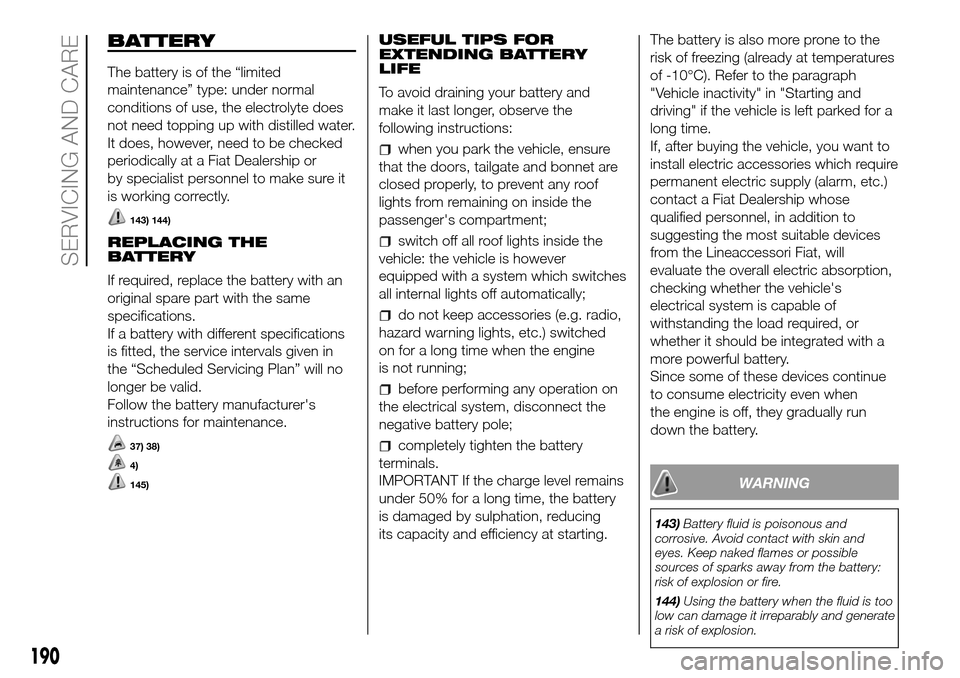
BATTERY
The battery is of the “limited
maintenance” type: under normal
conditions of use, the electrolyte does
not need topping up with distilled water.
It does, however, need to be checked
periodically at a Fiat Dealership or
by specialist personnel to make sure it
is working correctly.
143) 144)
REPLACING THE
BATTERY
If required, replace the battery with an
original spare part with the same
specifications.
If a battery with different specifications
is fitted, the service intervals given in
the “Scheduled Servicing Plan” will no
longer be valid.
Follow the battery manufacturer's
instructions for maintenance.
37) 38)
4)
145)
USEFUL TIPS FOR
EXTENDING BATTERY
LIFE
To avoid draining your battery and
make it last longer, observe the
following instructions:
when you park the vehicle, ensure
that the doors, tailgate and bonnet are
closed properly, to prevent any roof
lights from remaining on inside the
passenger's compartment;
switch off all roof lights inside the
vehicle: the vehicle is however
equipped with a system which switches
all internal lights off automatically;
do not keep accessories (e.g. radio,
hazard warning lights, etc.) switched
on for a long time when the engine
is not running;
before performing any operation on
the electrical system, disconnect the
negative battery pole;
completely tighten the battery
terminals.
IMPORTANT If the charge level remains
under 50% for a long time, the battery
is damaged by sulphation, reducing
its capacity and efficiency at starting.The battery is also more prone to the
risk of freezing (already at temperatures
of -10°C). Refer to the paragraph
"Vehicle inactivity" in "Starting and
driving" if the vehicle is left parked for a
long time.
If, after buying the vehicle, you want to
install electric accessories which require
permanent electric supply (alarm, etc.)
contact a Fiat Dealership whose
qualified personnel, in addition to
suggesting the most suitable devices
from the Lineaccessori Fiat, will
evaluate the overall electric absorption,
checking whether the vehicle's
electrical system is capable of
withstanding the load required, or
whether it should be integrated with a
more powerful battery.
Since some of these devices continue
to consume electricity even when
the engine is off, they gradually run
down the battery.
WARNING
143)Battery fluid is poisonous and
corrosive. Avoid contact with skin and
eyes. Keep naked flames or possible
sources of sparks away from the battery:
risk of explosion or fire.
144)Using the battery when the fluid is too
low can damage it irreparably and generate
a risk of explosion.
190
SERVICING AND CARE
Page 199 of 298
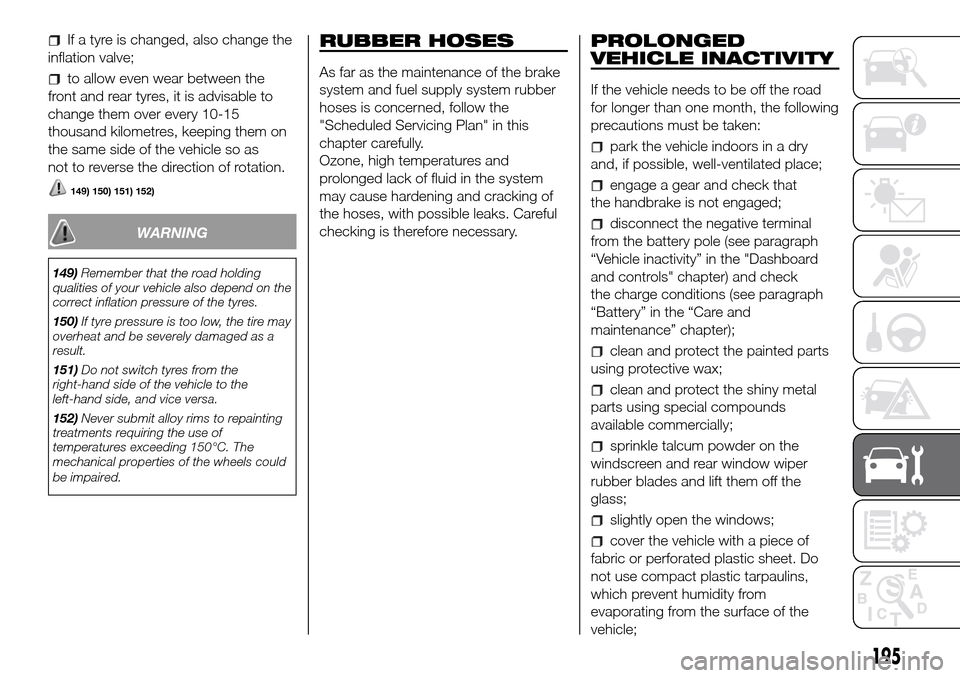
If a tyre is changed, also change the
inflation valve;
to allow even wear between the
front and rear tyres, it is advisable to
change them over every 10-15
thousand kilometres, keeping them on
the same side of the vehicle so as
not to reverse the direction of rotation.
149) 150) 151) 152)
WARNING
149)Remember that the road holding
qualities of your vehicle also depend on the
correct inflation pressure of the tyres.
150)If tyre pressure is too low, the tire may
overheat and be severely damaged as a
result.
151)Do not switch tyres from the
righthand side of the vehicle to the
lefthand side, and vice versa.
152)Never submit alloy rims to repainting
treatments requiring the use of
temperatures exceeding 150°C. The
mechanical properties of the wheels could
be impaired.
RUBBER HOSES
As far as the maintenance of the brake
system and fuel supply system rubber
hoses is concerned, follow the
"Scheduled Servicing Plan" in this
chapter carefully.
Ozone, high temperatures and
prolonged lack of fluid in the system
may cause hardening and cracking of
the hoses, with possible leaks. Careful
checking is therefore necessary.
PROLONGED
VEHICLE INACTIVITY
If the vehicle needs to be off the road
for longer than one month, the following
precautions must be taken:
park the vehicle indoors in a dry
and, if possible, well-ventilated place;
engage a gear and check that
the handbrake is not engaged;
disconnect the negative terminal
from the battery pole (see paragraph
“Vehicle inactivity” in the "Dashboard
and controls" chapter) and check
the charge conditions (see paragraph
“Battery” in the “Care and
maintenance” chapter);
clean and protect the painted parts
using protective wax;
clean and protect the shiny metal
parts using special compounds
available commercially;
sprinkle talcum powder on the
windscreen and rear window wiper
rubber blades and lift them off the
glass;
slightly open the windows;
cover the vehicle with a piece of
fabric or perforated plastic sheet. Do
not use compact plastic tarpaulins,
which prevent humidity from
evaporating from the surface of the
vehicle;
195
Page 201 of 298
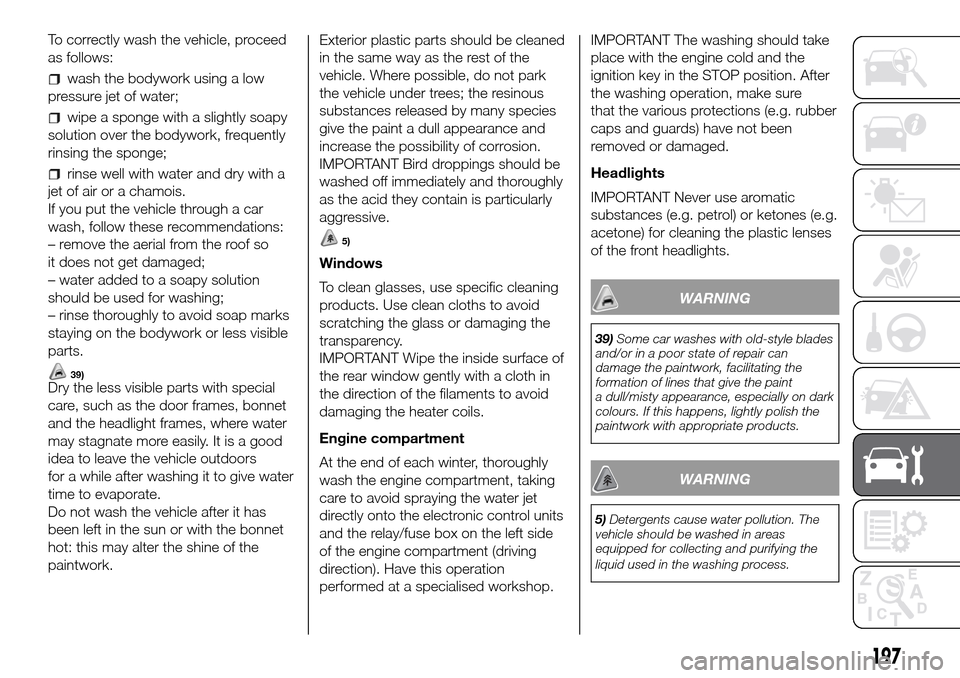
To correctly wash the vehicle, proceed
as follows:
wash the bodywork using a low
pressure jet of water;
wipe a sponge with a slightly soapy
solution over the bodywork, frequently
rinsing the sponge;
rinse well with water and dry with a
jet of air or a chamois.
If you put the vehicle through a car
wash, follow these recommendations:
– remove the aerial from the roof so
it does not get damaged;
– water added to a soapy solution
should be used for washing;
– rinse thoroughly to avoid soap marks
staying on the bodywork or less visible
parts.
39)Dry the less visible parts with special
care, such as the door frames, bonnet
and the headlight frames, where water
may stagnate more easily. It is a good
idea to leave the vehicle outdoors
for a while after washing it to give water
time to evaporate.
Do not wash the vehicle after it has
been left in the sun or with the bonnet
hot: this may alter the shine of the
paintwork.Exterior plastic parts should be cleaned
in the same way as the rest of the
vehicle. Where possible, do not park
the vehicle under trees; the resinous
substances released by many species
give the paint a dull appearance and
increase the possibility of corrosion.
IMPORTANT Bird droppings should be
washed off immediately and thoroughly
as the acid they contain is particularly
aggressive.
5)
Windows
To clean glasses, use specific cleaning
products. Use clean cloths to avoid
scratching the glass or damaging the
transparency.
IMPORTANT Wipe the inside surface of
the rear window gently with a cloth in
the direction of the filaments to avoid
damaging the heater coils.
Engine compartment
At the end of each winter, thoroughly
wash the engine compartment, taking
care to avoid spraying the water jet
directly onto the electronic control units
and the relay/fuse box on the left side
of the engine compartment (driving
direction). Have this operation
performed at a specialised workshop.IMPORTANT The washing should take
place with the engine cold and the
ignition key in the STOP position. After
the washing operation, make sure
that the various protections (e.g. rubber
caps and guards) have not been
removed or damaged.
Headlights
IMPORTANT Never use aromatic
substances (e.g. petrol) or ketones (e.g.
acetone) for cleaning the plastic lenses
of the front headlights.
WARNING
39)Some car washes with old-style blades
and/or in a poor state of repair can
damage the paintwork, facilitating the
formation of lines that give the paint
a dull/misty appearance, especially on dark
colours. If this happens, lightly polish the
paintwork with appropriate products.
WARNING
5)Detergents cause water pollution. The
vehicle should be washed in areas
equipped for collecting and purifying the
liquid used in the washing process.
197
Page 202 of 298
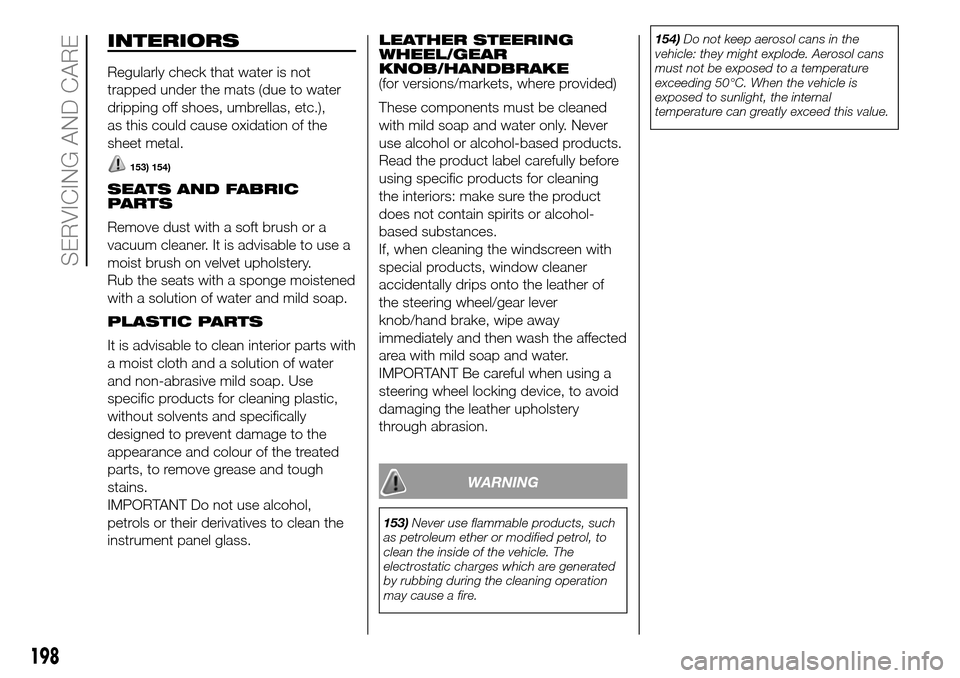
INTERIORS
Regularly check that water is not
trapped under the mats (due to water
dripping off shoes, umbrellas, etc.),
as this could cause oxidation of the
sheet metal.
153) 154)
SEATS AND FABRIC
PARTS
Remove dust with a soft brush or a
vacuum cleaner. It is advisable to use a
moist brush on velvet upholstery.
Rub the seats with a sponge moistened
with a solution of water and mild soap.
PLASTIC PARTS
It is advisable to clean interior parts with
a moist cloth and a solution of water
and non-abrasive mild soap. Use
specific products for cleaning plastic,
without solvents and specifically
designed to prevent damage to the
appearance and colour of the treated
parts, to remove grease and tough
stains.
IMPORTANT Do not use alcohol,
petrols or their derivatives to clean the
instrument panel glass.LEATHER STEERING
WHEEL/GEAR
KNOB/HANDBRAKE
(for versions/markets, where provided)
These components must be cleaned
with mild soap and water only. Never
use alcohol or alcohol-based products.
Read the product label carefully before
using specific products for cleaning
the interiors: make sure the product
does not contain spirits or alcohol-
based substances.
If, when cleaning the windscreen with
special products, window cleaner
accidentally drips onto the leather of
the steering wheel/gear lever
knob/hand brake, wipe away
immediately and then wash the affected
area with mild soap and water.
IMPORTANT Be careful when using a
steering wheel locking device, to avoid
damaging the leather upholstery
through abrasion.
WARNING
153)Never use flammable products, such
as petroleum ether or modified petrol, to
clean the inside of the vehicle. The
electrostatic charges which are generated
by rubbing during the cleaning operation
may cause a fire.154)Do not keep aerosol cans in the
vehicle: they might explode. Aerosol cans
must not be exposed to a temperature
exceeding 50°C. When the vehicle is
exposed to sunlight, the internal
temperature can greatly exceed this value.
198
SERVICING AND CARE
Page 295 of 298
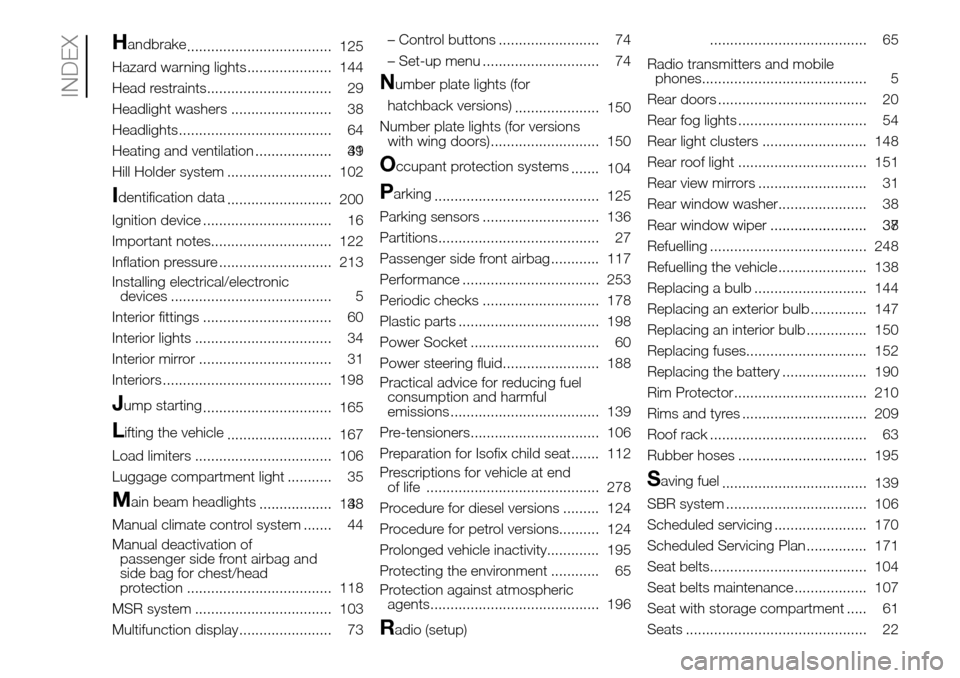
Handbrake
.................................... 125
Hazard warning lights..................... 144
Head restraints............................... 29
Headlight washers ......................... 38
Headlights...................................... 64
Heating and ventilation ................... 39................... 41
Hill Holder system .......................... 102
Identification data
.......................... 200
Ignition device ................................ 16
Important notes.............................. 122
Inflation pressure ............................ 213
Installing electrical/electronic
devices ........................................ 5
Interior fittings ................................ 60
Interior lights .................................. 34
Interior mirror ................................. 31
Interiors .......................................... 198
Jump starting
................................ 165
Lifting the vehicle
.......................... 167
Load limiters .................................. 106
Luggage compartment light ........... 35
Main beam headlights
.................. 33 .................. 148
Manual climate control system ....... 44
Manual deactivation of
passenger side front airbag and
side bag for chest/head
protection .................................... 118
MSR system .................................. 103
Multifunction display....................... 73– Control buttons ......................... 74
– Set-up menu ............................. 74
Number plate lights (for
hatchback versions)
..................... 150
Number plate lights (for versions
with wing doors)........................... 150
Occupant protection systems
....... 104
Parking
......................................... 125
Parking sensors ............................. 136
Partitions........................................ 27
Passenger side front airbag ............ 117
Performance .................................. 253
Periodic checks ............................. 178
Plastic parts ................................... 198
Power Socket ................................ 60
Power steering fluid........................ 188
Practical advice for reducing fuel
consumption and harmful
emissions ..................................... 139
Pre-tensioners................................ 106
Preparation for Isofix child seat....... 112
Prescriptions for vehicle at end
of life ........................................... 278
Procedure for diesel versions ......... 124
Procedure for petrol versions.......... 124
Prolonged vehicle inactivity............. 195
Protecting the environment ............ 65
Protection against atmospheric
agents.......................................... 196
Radio (setup)....................................... 65
Radio transmitters and mobile
phones......................................... 5
Rear doors ..................................... 20
Rear fog lights ................................ 54
Rear light clusters .......................... 148
Rear roof light ................................ 151
Rear view mirrors ........................... 31
Rear window washer...................... 38
Rear window wiper ........................ 37........................ 38
Refuelling ....................................... 248
Refuelling the vehicle ...................... 138
Replacing a bulb ............................ 144
Replacing an exterior bulb .............. 147
Replacing an interior bulb ............... 150
Replacing fuses.............................. 152
Replacing the battery ..................... 190
Rim Protector................................. 210
Rims and tyres ............................... 209
Roof rack ....................................... 63
Rubber hoses ................................ 195
Saving fuel
.................................... 139
SBR system ................................... 106
Scheduled servicing ....................... 170
Scheduled Servicing Plan ............... 171
Seat belts....................................... 104
Seat belts maintenance .................. 107
Seat with storage compartment ..... 61
Seats ............................................. 22
INDEX
Page 296 of 298

– Driver’s seat .............................. 22
– Passenger seat ......................... 23
– Rear seats ................................. 24
Seats and fabric parts .................... 198
Side bag ........................................ 121
Side bags....................................... 121
Side doors ..................................... 19
Side lights ...................................... 147
Side/tail lights................................. 32
Size................................................ 214
Ski rack.......................................... 63
Snow chains .................................. 141
Snow tyres ..................................... 141
Spare wheel ................................... 209
Spark plugs (type) .......................... 204
Speed block................................... 133
Spray nozzles................................. 193
Start&Stop system ......................... 127
Starting the engine ......................... 124Steering ......................................... 208
Steering wheel ............................... 30
Stopping the engine ....................... 125
Storage compartment .................... 60
Sun visors ...................................... 62
Supply ........................................... 207
Suspension .................................... 208
Symbols......................................... 4......................................... 17
The keys
....................................... 14
– Key with remote control............. 14
– Key without remote control........ 14
Third brake lights............................ 149
Towing the vehicle .......................... 167
Towing trailers ................................ 140
TPMS............................................. 130
Traction Plus system ...................... 135
Transmission .................................. 207
Trip computer................................. 80
Types of bulbs ................................ 145
Tyres .............................................. 209
Usage conditions
.......................... 140
Use of the Owner Handbook.......... 3
Useful tips for extending battery
life ................................................ 190
Using the gearbox .......................... 126
Vehicle exterior and underbody
warranty
....................................... 196
Vehicle modifications/alterations ..... 5
VIN plate ........................................ 200
Warming up the engine just
after it has started
........................ 125
Warning lights and messages......... 83
Weights.......................................... 219
Wheel geometry ............................. 209
Wheels ........................................... 209
Wheels and tyres ........................... 194
Windscreen / rear window wiper
(replacement) ............................... 192
Windscreen washer ....................... 37
Windscreen wiper .......................... 37
Windscreen/rear window washer
fluid .............................................. 187
FCA Italy S.p.A. - MOPAR - Technical Services - Service Engineering
Largo Senatore G. Agnelli, 3 - 10040 Volvera - Torino (Italia)
Print no. 603.99. - 0 /201 - 1 Edition 962 4 6